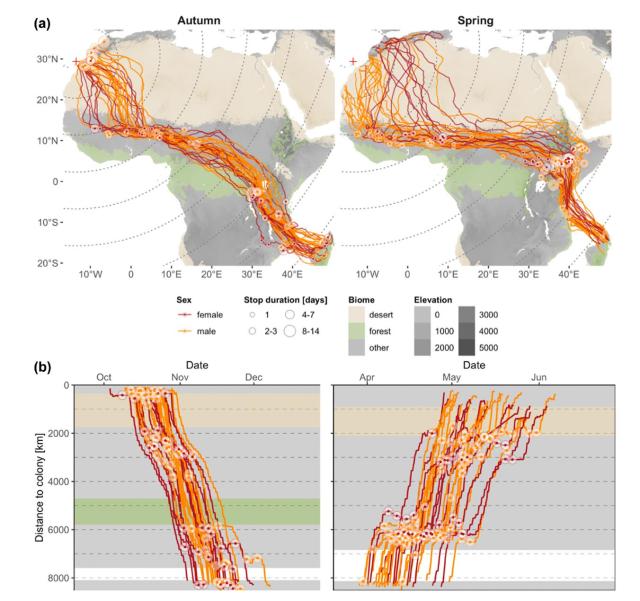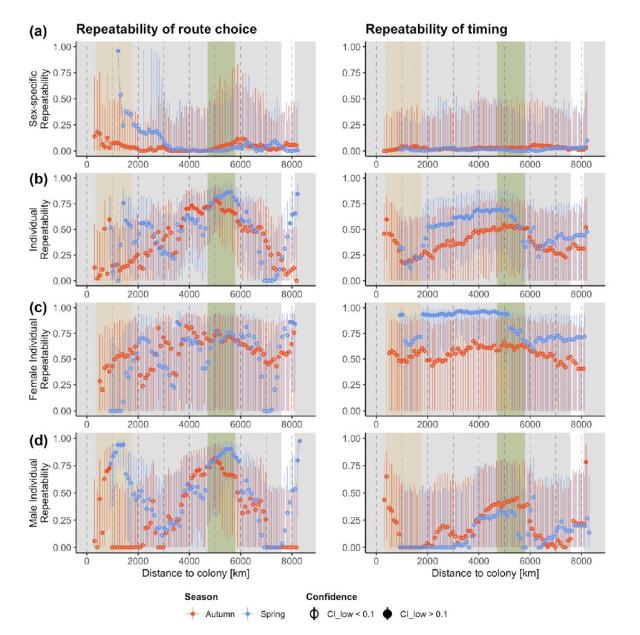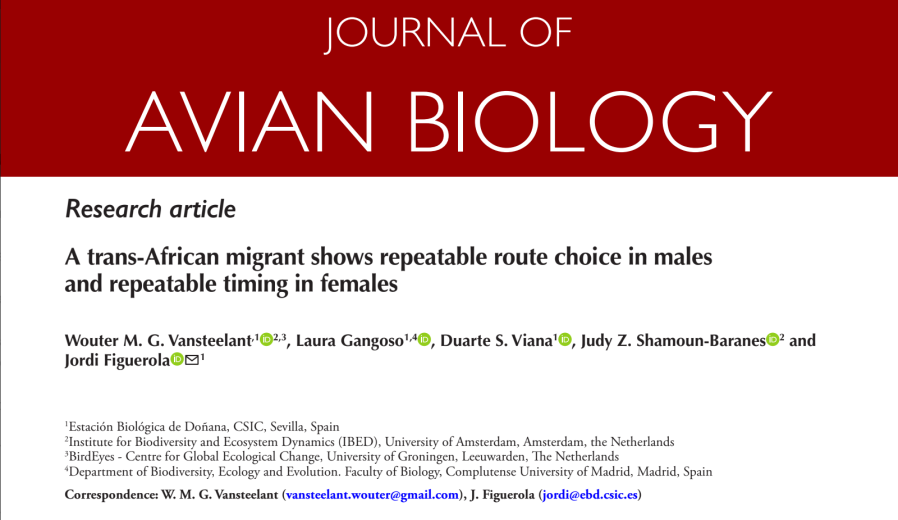Vansteelant, W. M., Gangoso, L., Viana, D. S., Shamoun‐Baranes, J. Z., & Figuerola, J. (2023). A trans‐African migrant shows repeatable route choice in males and repeatable timing in females. Journal of Avian Biology, e03050.
Los halcones de Eleonor muestran una ruta migratoria marcadamente zigzagueante entre sus zonas de cría en Canarias y sus zonas de invernada malgaches. Aún así, este corredor mide varios miles de kms de ancho en algunos lugares, y la fecha en que los halcones pasan por ciertas regiones varía hasta en 6 semanas. Para desentrañar cuánta de esta variación se debe a las diferencias individuales y de sexo en la elección de la ruta y el tiempo, en contraste a la flexibilidad de comportamiento dentro del individuo, utilizamos datos GPS de 5 halcones hembras y 8 machos en 2-4 migraciones repetidas cada uno. Esperábamos que la variabilidad del comportamiento tanto dentro del individuo como entre individuos pudiera diferir según el contexto regional y estacional. Encontramos patrones espaciotemporales complejos en la repetibilidad de rutas y tiempos, y la interpretación de estos patrones requirió una consideración cuidadosa de los cambios regionales y estacionales en ambos componentes de varianza. En contra de nuestras expectativas, los sexos mostraron mayores diferencias en la variabilidad y repetibilidad de su comportamiento, que en su elección de ruta y tiempo promedio. En general, los halcones parecen desarrollar rutas y horarios distintos individualmente en aquellas etapas migratorias donde las restricciones ambientales y del ciclo anual son relativamente débiles. El seguimiento continuado a lo largo de la vida de los individuos puede ayudar a explicar mejor cómo el sexo media el desarrollo individual.

Figura 1. Rutas de migración estacional (a) y (b) tiempo en halcones de Eleonor. (a) Las curvas grises discontinuas muestran la distancia a la colonia (cruz roja) en intervalos de 1000 km. Los biomas están coloreados para resaltar las barreras ecológicas que se sabe que los halcones evitan o cruzan relativamente rápido (desierto, mares/lagos y bosque húmedo tropical), mientras que las áreas grises consisten en sabanas de pastos, arbustos y bosques que pueden ofrecer oportunidades de alimentación. (b) El sombreado de fondo corresponde a los colores del bioma en el mapa y se basa en la distancia media a la colonia en la que los halcones comenzaron y terminaron cada uno de los principales cruces de barreras en cada temporada. El tamaño de los stop-overs es proporcional a la duración de las escalas en los mapas (a), pero no en los diagramas de tiempo (b).

Figura 2. Repetibilidad en la elección de la ruta del halcón de Eleonor (izquierda) y tiempo (derecha) a nivel de (a) sexos y (b) individuos y a nivel individual modelado por separado para (c) hembras y (d) machos.
Eleonora’s falcons show a markedly zigzagging migratory route between their breeding grounds in the Canary Islands and their Malagasy wintering grounds. Still, this corridor is several thousand kms wide in some places, and the date that the falcons pass through certain regions varies by up to 6 weeks. To tease out how much of this variation is due to individual and sex differences in route choice and timing, as opposed to within-individual behavioral flexibility, we used GPS data from 5 female and 8 male falcons at 2-4 repeated migrations each. We expected that both within-individual and between-individual variability in behavior might differ based on regional and seasonal context. We found complex spatiotemporal patterns in the repeatability of routes and times, and the interpretation of these patterns required careful consideration of regional and seasonal changes in both variance components. Contrary to our expectations, the sexes showed greater differences in the variability and repeatability of their behavior than in their choice of route and average time. In general, falcons seem to develop distinct routes and schedules individually in those migratory stages where environmental and annual cycle restrictions are relatively weak. Continued follow-up throughout the lives of individuals may help to better explain how sex mediates individual development.

Figure 1. Seasonal migration (a) routes and (b) schedules of 8 male and 5 female Eleonora’s falcons that were GPS-tracked across at least two migration cycles each. (a) The dashed grey curves show the distance to the colony (red cross) in 1000 km intervals. The biomes are colored to highlight ecological barriers that falcons are known to avoid or cross relatively quickly (desert, seas/lakes, and tropical moist forest), while grey areas consist of grassy, shrub, and woodland savannahs that may offer opportunities of feeding. (b) Background shading corresponds to biome colors on the map and is based on the mean distance to the colony at which falcons started and finished each major barrier crossing each season. The size of the stop-overs is proportional to the duration of the stopovers in the maps (a), but not in the time diagrams (b).

Figure 2. Repeatability in Eleonora’s falcon route choice (left) and timing (right) at the level of (a) sexes and (b) individuals and at individual level modelled separately for (c) females and (d) males.
